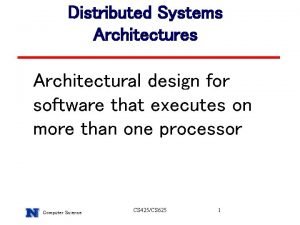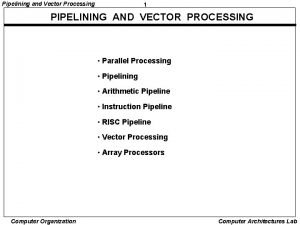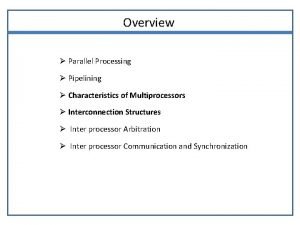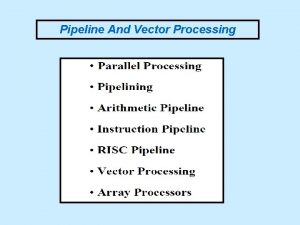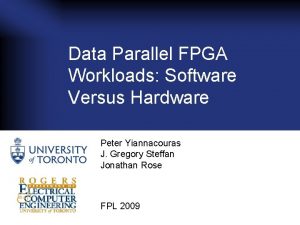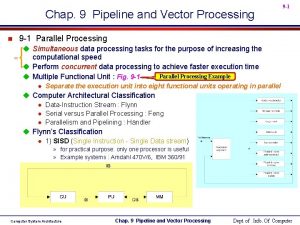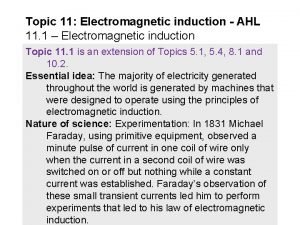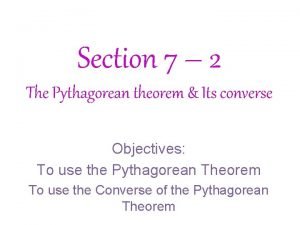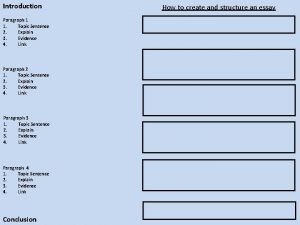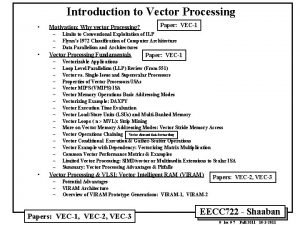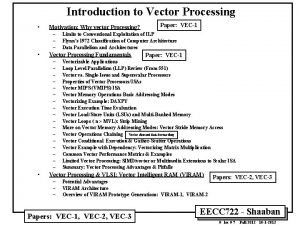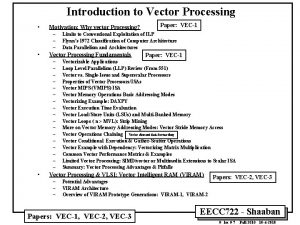Topic 2 Vector Processing Vector Architectures Lasciate Ogne











![Vector Length Control An Example: for(i = 0; i < n; ++i) y[i] = Vector Length Control An Example: for(i = 0; i < n; ++i) y[i] =](https://slidetodoc.com/presentation_image_h2/45c4aaef8629856a2eddf10d98caa3cb/image-12.jpg)































![Gather Operation V 0 V 1[i] = A[V 0[i]] VL 4 A 0 100 Gather Operation V 0 V 1[i] = A[V 0[i]] VL 4 A 0 100](https://slidetodoc.com/presentation_image_h2/45c4aaef8629856a2eddf10d98caa3cb/image-44.jpg)
![Scatter Operation A[V 0[i]] = V 1[i] VL 4 A 0 100 Example: A[V Scatter Operation A[V 0[i]] = V 1[i] VL 4 A 0 100 Example: A[V](https://slidetodoc.com/presentation_image_h2/45c4aaef8629856a2eddf10d98caa3cb/image-45.jpg)



























![Another Memory Layout Modulo 0 A[0] B[6] W[4] Modulo 1 A[1] B[7] W[5] Modulo Another Memory Layout Modulo 0 A[0] B[6] W[4] Modulo 1 A[1] B[7] W[5] Modulo](https://slidetodoc.com/presentation_image_h2/45c4aaef8629856a2eddf10d98caa3cb/image-73.jpg)















- Slides: 88

Topic 2 Vector Processing & Vector Architectures Lasciate Ogne Speranza, Voi Ch’Intrate Dante’s Inferno 9/18/2006 ELEG 652 -06 F 1

Reading List • Slides: Topic 2 x • Henn&Patt: Appendix G • Other assigned readings from homework and classes 9/18/2006 ELEG 652 -06 F 2

Vector Architectures Types: Memory-Memory Archs Register-Register Archs Vector Arch Components: Vector Register Banks Capable of holding a n number of vector elements. Two extra registers Vector Functional Units Fully pipelined, hazard detection (structural and data) Vector Load-Store Unit A Scalar Unit 9/18/2006 A set of registers, FUs and CUs ELEG 652 -06 F 3

An Intro to DLXV • A simplified vector architecture • Consist of one lane per functional unit – Lane: The number of vector instructions that can be executed in parallel by a functional unit • Loosely based on Cray 1 arch and ISA • Extension of DLX ISA for vector arch 9/18/2006 ELEG 652 -06 F 4

DLXV Configuration • Vector Registers – Eight Vector regs / 64 element each. – Two read ports and one write port per register – Sixteen read ports and eight write ports in total • Vector Functional Unit – Five Functional Units • Vector Load and Store Unit – A bandwidth of 1 word per cycle – Double as a scalar load / store unit • A set of scalar registers – 32 general and 32 FP regs 9/18/2006 ELEG 652 -06 F 5

A Vector / Register Arch Scalar Register File Vector Register File Main Memory Vector Load & Store FP Add FP Multiply FP Divide Logical Integer 9/18/2006 ELEG 652 -06 F 6

Advantages • A single vector instruction A lot of work • No data hazards – No need to check for data hazards inside vector instructions – Parallelism inside the vector operation • Deep pipeline or array of processing elements • Known Access Pattern – Latency only paid once per vector (pipelined loading) – Memory address can be mapped to memory modules to reduce contentions • Reduction in code size and simplification of hazards – Loop related control hazards from loop are eliminated. 9/18/2006 ELEG 652 -06 F 7

DAXPY: DLX Code Y=a*X+Y LD ADDI LD MULTD LD ADDD SD ADDI SUB BNZ Loop: F 0, a R 4, Rx, #512 F 2, 0(Rx) F 2, F 0, F 2 F 4, 0 (Ry) F 4, F 2, F 4, 0 (Ry) Rx, #8 Ry, #8 R 20, R 4, Rx R 20, loop ; last address to load ; load X(i) ; a x X(i) ; load Y(i) ; a x X(i) + Y(i) ; store into Y(i) ; increment index to X ; increment index to Y ; compute bound ; check if done The bold instructions are part of the loop index calculation and branching 9/18/2006 ELEG 652 -06 F 8

DAXPY: DLXV Code Y=a*X+Y LD LV MULTSV LV ADDV SV F 0, a V 1, Rx V 2, F 0, V 1 V 3, Ry V 4, V 2, V 3 Ry, V 4 ; load scalar a ; load vector X ; vector-scalar multiply ; load vector Y ; add ; store the result Instruction Number [Bandwidth] for 64 elements DLX Code DLXV Code 9/18/2006 578 Instructions 6 Instructions ELEG 652 -06 F 9

Dead Time The time that it takes the pipeline to be ready for the next vector instruction 9/18/2006 ELEG 652 -06 F 10

Issues • Vector Length Control – Vector lengths are not usually less or even a multiple of the hardware vector length • Vector Stride – Access to vectors may not be consequently • Solutions: – Two special registers • One for vector length up to a maximum vector length • One for vector mask 9/18/2006 ELEG 652 -06 F 11
![Vector Length Control An Example fori 0 i n i yi Vector Length Control An Example: for(i = 0; i < n; ++i) y[i] =](https://slidetodoc.com/presentation_image_h2/45c4aaef8629856a2eddf10d98caa3cb/image-12.jpg)
Vector Length Control An Example: for(i = 0; i < n; ++i) y[i] = a * x[i] +y[i] Question: Assume the maximum hardware vector length is MVL which may be less than n. How should we do the above computation ? 9/18/2006 ELEG 652 -06 F 12

Vector Length Control Strip Mining Original Code for(i = 0; i < n; ++i) y[i] = a * x[i] +y[i] Strip Mined Code Low = 0 VL = n % MVL for(j = 0; j < (int)(n / (float)(MVL) + 0. 5); ++j){ for(i = Low; i < Low + VL – 1; ++i) y[i] = a * x[i] + y[i]; Low += VL; VL = MVL; } 9/18/2006 ELEG 652 -06 F 13

Vector Length Control Strip Mining Value of j 0 Value of i 0 M-1 1 2 3 M M-MVL-1 M-MVL M-2*MVL-1 M-2*MVL M-3*MVL-1 n/MVL n-MVL-1 n-1 For a vector of arbitrary length M =n % MVL The vector length control register takes values similar to the Vector Length variable (VL) in the C code 9/18/2006 ELEG 652 -06 F 14

Vector Stride Matrix Multiply Code for(i = 0; i < n; ++i) for(j = 0; j < n; ++j){ c[i][j] = 0. 0; for(k = 0; k < n; ++k) c[i][j] += a[i][k] * b[k][j]; } How to vectorize this code? How stride works here? 9/18/2006 Consider that in C the arrays are saved in memory row-wise. Therefore, a and c are loaded correctly. How about b? ELEG 652 -06 F 15

Vector Stride • Stride for a and c 1 – Also called unit stride • Stride for b n elements • Use special instructions – Load and store with stride (LVWS, SVWS) • Memory banks Stride can complicate access patterns == Contention 9/18/2006 ELEG 652 -06 F 16

Vector Stride & Memory Systems Example Time to Complete a Load Memory System Eight Memory Banks Busy Time: 6 cycles Memory Latency: 12 cycles 12 + 1 + 6 * 63 391 Cycles for Stride 32 or 6. 2 cycle per element Vector 64 elements Stride of 1 and 32 9/18/2006 12 + 64 76 Cycles for Stride 1 or 1. 2 cycle per element ELEG 652 -06 F 17

Cray-1 “The World Most Expensive Love Seat. . . ” Picture courtesy of Cray Original Source: Cray 1 Computer System Hardware Reference Manual 9/18/2006 ELEG 652 -06 F 18

Cray 1 Data Sheet • • Designed by: Seymour Cray Price: 5 to 8. 8 Millions dollars Units Shipped: 85 Technology: SIMD, deep pipelined functional units • Performance: up to 160 MFLOPS • Date Released: 1976 • Best Know for: The computer that made the term supercomputer mainstream 9/18/2006 ELEG 652 -06 F 19

Architectural Components Computation Section Registers Functional Units Instruction Buffers MCU Memory Section From 0. 25 to 1 Million 64 -bit words Mass Storage Subsystem I/O Section 12 Input channels 12 Output channels 9/18/2006 Front End Comp. I/O Stations Peripheral Equipment ELEG 652 -06 F 20

The Cray-1 Architecture 9/18/2006 Vector Components Scalar Components Address & Instruction Calculation Components ELEG 652 -06 F 21 Computation Section

Architecture Features • 64 -bit word • 12. 5 nanosecond clock period • 2’s Complement arithmetic • Scalar and Vector Processing modes • Twelve functional units • Eight 24 -bit address registers (A) • Sixty Four 24 -bit intermediate address (B) registers 9/18/2006 • Eight 64 -bit scalar (S) registers • Sixty four 64 -bit intermediate scalar (T) registers • Eight 64 -element vector (V) registers, 64 -bit per element • Four Instructions buffers of 64 16 -bit parcels each • Integer and floating point arithmetic • 128 Instruction codes ELEG 652 -06 F 22

Architecture Features • Up to 1, 048, 576 words memory • Twelve input and twelve output channels • Loss data detection • Channel group – 64 data bits and 8 error correction bits • Eight or sixteen banks of 65, 536 words each • Busy Bank time: 4 • Transfer rate: – Contains either six input or six output channels – Served equally by memory (scanned every 4 cycles) – Priority resolved within the groups – Sixteen data bits, 3 controls bits per channel and 4 parity bits – B, T, V registers One word per cycle – A, S registers One word per two cycles – Instruction Buffers Four words per clock cycle • SEC - DED 9/18/2006 Original Source: Cray 1 Computer System Hardware Reference Manual ELEG 652 -06 F 23

Register-Register Architecture • All ALU operands are in registers • Registers are specialized by function (A, B, T, etc) thus avoiding conflict • Transfer between Memory and registers is treated differently than ALU • RISC based idea • Effective use of the Cray-1 requires careful planning to exploit its register resources – 4 Kbytes of high speed registers 9/18/2006 ELEG 652 -06 F 24

Registers Primary Registers Directly addressable by the Functional Units Named V (vector), S (scalar) and A (address) Intermediate Registers Used as buffers for the functional units Named T (Scalar transport) and B (Address buffering) M 9/18/2006 IR PR ELEG 652 -06 F FU 25

Registers • Memory Access Time: 11 cycles • Register Access Time: 1 ~ 2 cycles • Primary Registers: – Address Regs: 8 x 24 bits – Scalar Regs: 8 x 64 bits – Vector Regs: 8 x 64 words • Intermediate Registers: – B Regs: 64 x 24 bits – T Regs: 64 x 64 bits • Special Registers: – Vector Length Register: 0 <= VL <= 64 – Vector Masks Register: 64 bits • Total Size: 4, 888 bytes 9/18/2006 ELEG 652 -06 F 26

Instruction Format A parcel 16 -bit Instruction word 16 (one parcel) or 32 (two parcels) according to type A Two Parcels Instruction: Memory Instruction Word A One Parcel Instruction: Arithmetic Logical Instruction Word 4 3 3 4 3 22 Op code Op Code Result Reg Addr Index Reg Operand reg Result Reg Address Operand reg 9/18/2006 3 ELEG 652 -06 F 27

Functional Unit Pipelines Functional pipelines 9/18/2006 Register usage Pipeline delays (clock periods) Address functional units Address add unit Address multiply unit A A 2 6 Scalar functional units Scalar add unit Scalar shift unit Scalar logical unit Population/leading zero count unit S S 3 2 or 3 1 3 Vector functional units Vector add unit Vector shift unit Vector logical unit V or S 3 4 2 Floating-point functional units Floating-point add unit Floating-point multiply unit Reciprocal approximation unit S and V ELEG 652 -06 F 6 7 14 28

Vector Units • Vector Addition / Subtraction – Functional Unit Delay: 3 • Vector Logical Unit – Boolean Ops between 64 bit elements of the vectors • AND, XOR, MERGE, MASK GENERATION – Functional Unit Delay: 2 • Vector Shift – Shift values of a 64 bit (or 128 bits) element of a vector – Functional Unit Delay: 4 9/18/2006 ELEG 652 -06 F 29

Instruction Set • • 128 Instructions Ten Vector Types Thirteen Scalar Types Three Addressing Modes 9/18/2006 ELEG 652 -06 F 30

Implementation Philosophy • Instruction Processing – Instruction Buffering: Four Instructions buffers of 64 16 -bit parcels each • Memory Hierarchy – Memory Banks, T and B register banks • Register and Function Unit Reservation – Example: Vector ops, register operands, register result and FU are checked as reserved • Vector Processing 9/18/2006 ELEG 652 -06 F 31

Instruction Processing “Issue one instruction per cycle” • 4 x 64 word • 16 - 32 bit instructions • Instruction parcel pre-fetch • Branch in buffer • 4 inst/cycle fetched to LRU I-buffer Special Resources P, NIP, CIP and LIP 9/18/2006 ELEG 652 -06 F 32

Reservations • Vector operands, results and functional unit are marked reserved • The vector result reservation is lifted when the chain slot time has passed – Chain Slot: Functional Unit delay plus two clock cycles Examples: V 1 = V 2 * V 3 V 4 = V 5 + V 6 Independent 9/18/2006 V 1 = V 2 * V 3 V 4 = V 5 + V 2 Second Instruction cannot begin until First is finished ELEG 652 -06 F V 1 = V 2 * V 3 V 4 = V 5 * V 6 Ditto 33

V. Instructions in the Cray-1 Vj ~ 1 2 3 ~ ~ Vi 1 2 3 Vk . . . Vk n ~ ~ n Vi ~ ~ (b) Type 2 vector instruction (a) Type 1 vector instruction 9/18/2006 . . . ~ Sj ELEG 652 -06 F 34

V. Instructions in the Cray-1 Memory Vj ~ Vi ~ Memory 1 2 3 4 5 6 7 1 2 3 4 5 6 ~ (c) Type 3 vector instruction 9/18/2006 ~ (d) Type 4 vector instruction ELEG 652 -06 F 35

Vector Loops • Long vectors with N > 64 are sectioned • Each time through a vector loop 64 elements are processed • Remainder handling • “transparent” to the programmer 9/18/2006 ELEG 652 -06 F 36

V. Chaining • Internal forwarding techniques of 360/91 • A “linking process” that occurs when results obtained from one pipeline unit are directly fed into the operand registers of another function pipe. • Chaining allow operations to be issued as soon as the first result becomes available • Registers/F-units must be properly reserved. • Limited by the number of Vector Registers and Functional Units • From 2 to 5 9/18/2006 ELEG 652 -06 F 37

d . . . Adding 1 f VO j 1 2 j. V 4 . . . Logical Product Pipe Memory fetch pipe c V 1 V 2 g 1 2 V 3 3 4 Right shift pipe i l 9/18/2006 . . . 3 Chain Slot 1 2 3 4 5 6 7 d 2 . . . Vector add pipe Fetching Adding . . . Fetching M e m o r y (M-fetch) (V-add) (left shift) (logical product) . . . Chaining Example Mem V 0 + V 1 V 2 < A 3 V 3 ^ V 4 V 5 a ELEG 652 -06 F V 5 38

Y(1: N) = A x X(1: N) + Y(1: N) Read/write port Read port 1 Access Pipe (Load X) . . . (Load Y) Access Pipe (Load Y) V 2 . . . V 1 . . Vector register V 1 Memory S Scalar register (S*) . . Multiply Pipe . . Add Pipe V 3. . Multiply Pipe . . (S*) V 1 . . S V 3 Add Pipe V 4 . . (Vadd) (VAdd) Access Pipe (Store Y) Access Pipe. . (Store Y) . . V 2 Access Pipe . . (Load X) Memory Read/write port Limited chaining using only one memory-access pipe in the Gray 1 9/18/2006 Read port 2 Memory Vector register . . Multipipeline chaining SAXPY code Memory ELEG 652 -06 F write port Memory Complete chaining using three memory-access pipes in the Cray X-MP 39

Cray 1 Performance • 3 to 160 MFLOPS – Application and Programming Skills • Scalar Performance: 12 MFLOPS • Vector Dot Product: 22 MFLOPS • Peak Performance: 153 MFLOPS 9/18/2006 ELEG 652 -06 F 40

Cray X-MP Data Sheet • • Designed by: Steve Chen Price: 15 Millions dollars Units Shipped: N/A Technology: SIMD, deep pipelined functional units • Performance: up to 200 MFLOPS (for single CPU) • Date Released: 1982 • Best Know for: The Successor of Cray 1 and the first parallel vector computer from Cray Inc. An NSA CRAY X-MP/24, on exhibit at the National Crypto logic Museum. 9/18/2006 ELEG 652 -06 F 41

Cray X-MP • Multiprocessor/multiprocessing • 8 times of Cray-1 memory bandwidth • Clock 9. 5 ns - 8. 5 ns • Scalar speedup*: 1. 25 ~ 2. 5 • Throughput*: 2. 5 ~ 5 times 9/18/2006 ELEG 652 -06 F 42 *Speedup with respect to Cray 1

Irregular Vector Ops • Scatter: Use a vector to scatter another vector elements across Memory – X[A[i]] = B[i] • Gather: The reverse operation of scatter – X[i] = B[C[i]] • Compress – Using a Vector Mask, compress a vector • No Single instruction to do these before 1984 – Poor Performance: 2. 5 MFLOPS 9/18/2006 ELEG 652 -06 F 43
![Gather Operation V 0 V 1i AV 0i VL 4 A 0 100 Gather Operation V 0 V 1[i] = A[V 0[i]] VL 4 A 0 100](https://slidetodoc.com/presentation_image_h2/45c4aaef8629856a2eddf10d98caa3cb/image-44.jpg)
Gather Operation V 0 V 1[i] = A[V 0[i]] VL 4 A 0 100 Example: V 1[2] = A[V 0[2]] = A[7] = 250 9/18/2006 V 1 4 2 7 0 200 300 400 500 600 700 100 250 350 V 1 4 2 7 0 600 400 250 200 ELEG 652 -06 F Memory Contents / Addresses 100 140 180 1 C 0 200 240 280 2 C 0 300 Memory Contents / Addresses 200 300 400 500 600 700 100 250 350 100 140 180 1 C 0 200 240 280 2 C 0 30044 0 1 2 3 4 5 6 7 8
![Scatter Operation AV 0i V 1i VL 4 A 0 100 Example AV Scatter Operation A[V 0[i]] = V 1[i] VL 4 A 0 100 Example: A[V](https://slidetodoc.com/presentation_image_h2/45c4aaef8629856a2eddf10d98caa3cb/image-45.jpg)
Scatter Operation A[V 0[i]] = V 1[i] VL 4 A 0 100 Example: A[V 0[0]] = V 1[0] A[4] = 200 *(0 x 200)= 200 9/18/2006 V 0 V 1 4 2 7 0 200 300 400 500 ELEG 652 -06 F Memory Contents / Addresses x x x x x 100 140 180 1 C 0 200 240 280 2 C 0 300 Memory Contents / Addresses 500 x 300 x 200 x x 400 x 100 140 180 1 C 0 200 240 280 2 C 0 30045 0 1 2 3 4 5 6 7 8

Vector Compression Operation V 0 0 1 2 VL 14 VM 010110011101 … 3 4 5 6 7 8 9 10 11 12 13 V 0 V 1 = Compress(V 0, VM, Z) 9/18/2006 V 1 0 -1 0 5 -15 0 0 24 -7 13 0 -17 0 0 1 -1 2 0 3 5 4 -15 5 0 0 6 7 24 8 -7 9 13 0 -17 ELEG 652 -06 F 0 0 V 1 01 03 04 07 08 09 11 46

Characteristics of Several Vector Architectures 9/18/2006 ELEG 652 -06 F 47

The VMIPS Vector Instructions A MIPS ISA extended to support Vector Instructions. The same as DLXV 9/18/2006 ELEG 652 -06 F 48

Multiple Lanes 9/18/2006 ELEG 652 -06 F 49

Vectorizing Compilers 9/18/2006 ELEG 652 -06 F 50

Topic 2 a Performance Analysis of Vector Architectures 9/18/2006 ELEG 652 -06 F 51

Serial, Parallel and Pipelines x y 1 2 3 4 z=x+y Overlap Serial Replicate x 1 y 1 Pipeline x 1 y 1 1 x 2 y 2 2 1 3 2 4 3 z 1 4 z 2 1 result per cycle 1 2 3 4 z 1 x 2 y 2 1 2 3 4 z 2 Array x 1 y 1 x 2 y 2 1 2 3 4 z 1 z 2 N result per cycle 1 result per 4 cycles 9/18/2006 ELEG 652 -06 F 52

Generic Performance Formula (R. Hockney & C. Jesshope 81) MFLOPS performance of the architecture with an infinite length vector The vector length needed to achieve half of the peak performance Vector length 9/18/2006 ELEG 652 -06 F 53

Serial Architecture Generic Formula: 1 2 3 4 z 1 x 2 y 2 1 2 3 4 Parameters: z 2 Number of stages Time per stage Start up time 9/18/2006 ELEG 652 -06 F 54

Pipeline Architecture The number of elements that will come out of the pipeline after the initial penalty has been paid Generic Formula: Initial Penalty 1 2 3 4 Parameters: s 1 2 3 4 l Number of stages Time per stage Start up time 9/18/2006 ELEG 652 -06 F 55

Thus … • The Asymptotic Performance Parameter – Memory Limited Peak Performance Factor. A scale factor applied to the performance of a particular architecture implemented with a particular technology. Equivalent to a serial processor with a 100% cache miss • The N half Parameter – The amount of parallelism that is presented in a given architecture. – Determined by a combination of vector unit startup and vector unit latency 9/18/2006 ELEG 652 -06 F 56

The N Half Range 0 ∞ Serial Machine Infinite array of processor The relative performance of different algorithms on a computer is determined by the value of N half (matching problem parallelism with architecture parallelism) 9/18/2006 ELEG 652 -06 F 57

Vector Length v. s. Vector Performance t Slope: n 9/18/2006 ELEG 652 -06 F 58

Pseudo code Asymptotic and N half Calculation overhead = -clock(); overhead += clock(); for(N = 0; N < NMAX; ++N){ time[N] = -clock(); for(i = 0; i < N; ++i) A[i] = B[i] * C[i]; time[N] += clock(); time[N] = time[N] - overhead; } 9/18/2006 ELEG 652 -06 F 59

Parameters of Several Parallel Architectures Computer N half R infinity Nv CRAY-1 10 -20 80 1. 5 -3 BSP 25 -150 50 1 -8 2 -pipe CDC CYBER 205 100 11 1 -pipe TIASC 30 12 7 CDC STAR 100 150 25 12 (64 x 64) ICL DAP 2048 16 5 9/18/2006 ELEG 652 -06 F 60

Another Example The Chaining Effect Assume m vector operations unchained Thus Assume that all s’s are the same. The same goes for the l’s So 9/18/2006 ELEG 652 -06 F 61

Another Example The Chaining Effect Assume m vector operations chained Thus So 9/18/2006 ELEG 652 -06 F 62

Explanation Unchained Vop 1 Vop 2 Vop 3 Chained s+l Vop 1 Vop 2 Vop 3 Usually this would mean an increase in r∞ and N 1/2 by m 9/18/2006 ELEG 652 -06 F 63

Topic 2 b Memory System Design in Vector Machines 9/18/2006 ELEG 652 -06 F 64

Bandwidth Challenge Multi Port Memory System Stream A Stream B Pipelined Adder Processor Array Stream C = A + B A vector addition is possible when two vectors (data stream) are processed by vector hardware. This being vector adder or a processor array. 9/18/2006 ELEG 652 -06 F 65

Memory in Vector Architectures • Increase bandwidth M – Make “wider” memory M • Wider busses – Create several memory banks • Interleaved Memory Banks – – – Several Memory Banks Shared resources Broadcast of memory access Interleaving factor Number of Banks >= Bank Busy Time Stream A M M Stream B Pipelined Adder M M Stream C = A + B M M • Independent Memory Banks – The same idea as Interleaved memory – Independent resources 9/18/2006 ELEG 652 -06 F 66

However … • Vector machines prefer independent memory banks. – Multiple loads or stores per clock • Memory bank cycle time > CPU cycle time – Striding – Parallel processors 9/18/2006 ELEG 652 -06 F 67

Bandwidth Requirement • Assume d being the cycles to access a module • Thus BW 1 is equal to 1/d words per cycle – It means that after d cycles you will get a word • Restrictions: Most [Vector] memory systems requires at least a word per cycle!!!! • Imagine that a requirement of 3 words per cycle (two reads and one write) for total bandwidth (TBW) • Thus, Total Number of Modules = TBW / BW 1 – For a total of 3 d Modules (3/1/d 3 d) 9/18/2006 ELEG 652 -06 F 68

Bandwidth Example The Cray T 90 Clock Cycle: 2. 167 ns Largest Configuration: 32 Maximum Memory requests per cycle: 6 (Four Loads and Two stores) SRAM Time: 15 ns Busy Time 15 / 2. 167 = 6. 9 ~ 7 Cycles Memory Requests 6 * 32 = 192 In flight requests Number of Banks TBW / BW 1 = 192 * 7 1344 Historical Note: Cray T 90 early configurations only supported up to 1024 Memory Banks 9/18/2006 ELEG 652 -06 F 69

Bandwidth v. s. Latency If each element is in a different memory module, does this guarantees maximum bandwidth? ? NO For each module An initialization rate named r r * d <= 100% r <= 1/d 9/18/2006 A latency to access a word d rm <= m / d BW <= m / d ELEG 652 -06 F 70

An Example • How arrays A, B, and W should be layout in memory such that the memory can sustain one operation per cycle for the following operation: W = A + B; • If elements from W, A and B should start from module 0, Conflict will result!!! 9/18/2006 ELEG 652 -06 F 71

The Memory Accesses Assume: Pipeline adder has 4 stages, memory cycle time = 2 B[0] is ready!!! A[0] is ready!!! 9/18/2006 ELEG 652 -06 F W[0] is written back W[0] has been computed but it cannot be written back!! 72
![Another Memory Layout Modulo 0 A0 B6 W4 Modulo 1 A1 B7 W5 Modulo Another Memory Layout Modulo 0 A[0] B[6] W[4] Modulo 1 A[1] B[7] W[5] Modulo](https://slidetodoc.com/presentation_image_h2/45c4aaef8629856a2eddf10d98caa3cb/image-73.jpg)
Another Memory Layout Modulo 0 A[0] B[6] W[4] Modulo 1 A[1] B[7] W[5] Modulo 2 A[2] B[0] W[6] Modulo 3 A[3] B[1] W[7] Modulo 4 A[4] B[2] W[0] Modulo 5 A[5] B[3] W[1] Modulo 6 A[6] B[4] W[2] Modulo 7 A[7] B[5] W[3] 9/18/2006 ELEG 652 -06 F 73

Memory Access Assume: Pipeline adder has 4 stages, memory cycle time = 2 Both A[0] and B[0] are ready 9/18/2006 W[0] is ready and writing back ELEG 652 -06 F 74

2 -D Array Layout M 0 M 1 M 2 M 3 M 4 M 5 M 6 M 7 a(0, 0) a(1, 0) a(2, 0) a(3, 0) a(4, 0) a(5, 0) a(6, 0) a(7, 0) a(0, 1) a(1, 1) a(2, 1) a(3, 1) a(4, 1) a(5, 1) a(6, 1) a(7, 1) a(0, 2) a(1, 2) a(2, 2) a(3, 2) a(4, 2) a(5, 2) a(6, 2) a(7, 2) a(0, 3) a(1, 3) a(2, 3) a(3, 3) a(4, 3) a(5, 3) a(6, 3) a(7, 3) a(0, 4) a(1, 4) a(2, 4) a(3, 4) a(4, 4) a(5, 4) a(6, 4) a(7, 4) a(0, 5) a(1, 5) a(2, 5) a(3, 5) a(4, 5) a(5, 5) a(6, 5) a(7, 5) a(0, 6) a(1, 6) a(2, 6) a(3, 6) a(4, 6) a(5, 6) a(6, 6) a(7, 6) a(0, 7) a(1, 7) a(2, 7) a(3, 7) a(4, 7) a(5, 7) a(6, 7) a(7, 7) 9/18/2006 ELEG 652 -06 F 75

Row and Column Access M 0 a(0, 0) a(1, 0) a(2, 0) a(3, 0) a(4, 0) a(5, 0) a(6, 0) a(7, 0) M 1 M 2 M 3 M 4 M 5 M 6 M 7 a(0, 1) a(1, 1) a(2, 1) a(3, 1) a(4, 1) a(5, 1) a(6, 1) a(7, 1) a(0, 2) a(1, 2) a(2, 2) a(3, 2) a(4, 2) a(5, 2) a(6, 2) a(7, 2) a(0, 3) a(1, 3) a(2, 3) a(3, 3) a(4, 3) a(5, 3) a(6, 3) a(7, 3) a(0, 4) a(1, 4) a(2, 4) a(3, 4) a(4, 4) a(5, 4) a(6, 4) a(7, 4) a(0, 5) a(1, 5) a(2, 5) a(3, 5) a(4, 5) a(5, 5) a(6, 5) a(7, 5) a(0, 6) a(1, 6) a(2, 6) a(3, 6) a(4, 6) a(5, 6) a(6, 6) a(7, 6) a(0, 7) a(1, 7) a(2, 7) a(3, 7) a(4, 7) a(5, 7) a(6, 7) a(7, 7) Good for Column Vectors 9/18/2006 M 0 a(0, 0) a(0, 1) a(0, 2) a(0, 3) a(0, 4) a(0, 5) a(0, 6) a(0, 7) Good for Row Vectors M 1 M 2 M 3 M 4 M 5 M 6 M 7 a(1, 0) a(1, 1) a(1, 2) a(1, 3) a(1, 4) a(1, 5) a(1, 6) a(1, 7) a(2, 0) a(2, 1) a(2, 2) a(2, 3) a(2, 4) a(2, 5) a(2, 6) a(2, 7) a(3, 0) a(3, 1) a(3, 2) a(3, 3) a(3, 4) a(3, 5) a(3, 6) a(3, 7) a(4, 0) a(4, 1) a(4, 2) a(4, 3) a(4, 4) a(4, 5) a(4, 6) a(4, 7) a(5, 0) a(5, 1) a(5, 2) a(5, 3) a(5, 4) a(5, 5) a(5, 6) a(5, 7) a(6, 0) a(6, 1) a(6, 2) a(6, 3) a(6, 4) a(6, 5) a(6, 6) a(6, 7) a(7, 0) a(7, 1) a(7, 2) a(7, 3) a(7, 4) a(7, 5) a(7, 6) a(7, 7) ELEG 652 -06 F 76

What to do? • Use algorithms that – Access row or column exclusively – Possible for some (i. e. LU decomposition) but not for others • Skew the matrix 9/18/2006 ELEG 652 -06 F 77

Row and Column Layout M 0 M 1 M 2 M 3 M 4 M 5 M 6 M 7 a(0, 0) a(0, 1) a(0, 2) a(0, 3) a(0, 4) a(0, 5) a(0, 6) a(0, 7) a(1, 0) a(1, 1) a(1, 2) a(1, 3) a(1, 4) a(1, 5) a(1, 6) a(2, 0) a(2, 1) a(2, 2) a(2, 3) a(2, 4) a(2, 5) a(3, 0) a(3, 1) a(3, 2) a(3, 3) a(3, 4) a(4, 0) a(4, 1) a(4, 2) a(4, 3) a(5, 0) a(5, 1) a(5, 2) a(6, 0) a(6, 1) a(1, 7) a(2, 6) a(2, 7) a(3, 5) a(3, 6) a(3, 7) a(4, 4) a(4, 5) a(4, 6) a(4, 7) a(5, 3) a(5, 4) a(5, 5) a(5, 6) a(5, 7) a(6, 2) a(6, 3) a(6, 4) a(6, 5) a(6, 6) a(6, 7) a(7, 1) a(7, 2) a(7, 3) a(7, 4) a(7, 5) a(7, 6) Row stride 1 Column Stride ? 9/18/2006 a(7, 0) a(7, 7) Problem: Diagonals!!!!! ELEG 652 -06 F 78

Vector Access Specs • Initial Address – Association between addresses and memory banks in independent memory banks • Number of elements – Needed for the vector control length and the possible multiple access to memory • Precision of the elements – Vector or Floating point (if shared) • Stride – Memory access and memory bank detection 9/18/2006 ELEG 652 -06 F 79

Tricks for Strided Access • If array A was saved consequently in across M memory modules • Assume that V is a subset of A and it has an access stride of S • Then M consequently access to V will be dropped in Memory Modules 9/18/2006 ELEG 652 -06 F 80

Our Example Number of Memory Modules (M): 8 Row stride is 1 GCD(M, S) = 1 Column stride is 9 GCD(M, S) = 1 In general, if M = 2 k Select S = M + 1 (odd) Guarantees GCD(M, S) = 1 9/18/2006 ELEG 652 -06 F 81

Another Approach • Let M be prime – All GCD(M, S) where S < M will be 1 • Example: The Burroughs Scientific Processor (BSP) [Kuck & Budnick 71] • 16 PE • 17 Memory • 2 Alignment Networks 9/18/2006 ELEG 652 -06 F 82

The Burroughs Scientific Processor M M M M 17 M 17 Input Alignment Network Output Alignment Network 16 16 P P 9/18/2006 P P P P ELEG 652 -06 F P P P 83

Special Note and Other Approaches • If memory time is one cycle (i. e. d = 1) then consecutive access causes no problem (not the case at all) • Another solution to reduce contention – RANDOMIZE!!!! – Generate a random bank to save a word – Used by the Tera MTA 9/18/2006 ELEG 652 -06 F 84

Questions? ? Comments? ? 9/18/2006 ELEG 652 -06 F 85

Bibliography • Stork, Christian. “Exploring the Tera MTA by Example” May 10, 2000 • Cray 1 Computer System Hardware Reference Manual • Koopman, Phillips, “ 17. Vector Performance”, November 9, 1998. A lecture in Carnegie Mellon University 9/18/2006 ELEG 652 -06 F 86

Side Note 2 Gordon Bells’ Rules for Supercomputers • Put attention to performance • Orchestrate your resources • Scalars are bottlenecks – Plan your scalar section very carefully • Use existing (affordable) technology to provide a peak vector performance – Vector Performance: Bandwidth and vector register capacity. – Rule of Thumb: At least two results per cycle • Do not ignore expensive ops – Division are uncommon but they are used!!!! • Design to Market – Create something to brag about 9/18/2006 ELEG 652 -06 F 87

Side Note 2 Gordon Bells’ Rules for Supercomputers • 10 ~ 7 – Support around two extra bits of addressing per 3 years (10 years ~= 7 bits) • Increase Productivity • Stand on the shoulders of giants • Pipeline your design – Design for one and then other… • Give you enough lay time in your schedule for unexpected – Beware of Murphy’s Laws!!!! 9/18/2006 ELEG 652 -06 F 88
 Se lasciate che affiora in voi stessi
Se lasciate che affiora in voi stessi Se lasciate che affiora in voi stessi
Se lasciate che affiora in voi stessi Gui architectures
Gui architectures Integral vs modular design
Integral vs modular design 3-tier data warehouse architecture
3-tier data warehouse architecture Autoencoders, unsupervised learning, and deep architectures
Autoencoders, unsupervised learning, and deep architectures Gpu cache coherence
Gpu cache coherence Database system architectures
Database system architectures Database storage architecture
Database storage architecture What is e-commerce architecture
What is e-commerce architecture Instruction set architecture isa
Instruction set architecture isa Theo schlossnagle
Theo schlossnagle Why systolic architectures
Why systolic architectures Cdn architectures
Cdn architectures Ansi/sparc
Ansi/sparc Distributed systems architectures
Distributed systems architectures Architecture
Architecture Scalable web architectures
Scalable web architectures Backbone network architectures
Backbone network architectures Backbone network architectures
Backbone network architectures /topic/ down
/topic/ down General topic example
General topic example Histogram processing in digital image processing
Histogram processing in digital image processing Point processing in image processing
Point processing in image processing Neighborhood processing in image processing
Neighborhood processing in image processing Parallel processing vs concurrent processing
Parallel processing vs concurrent processing Gonzalez
Gonzalez Bottom up vs top down processing
Bottom up vs top down processing Primary and secondary processing of food
Primary and secondary processing of food Bottom up.processing
Bottom up.processing Gloria suarez
Gloria suarez Point processing
Point processing Neighborhood processing in digital image processing
Neighborhood processing in digital image processing Batch processing and interactive processing
Batch processing and interactive processing Bottom-up processing examples
Bottom-up processing examples Pipeline and vector processing
Pipeline and vector processing Vpp cisco
Vpp cisco Time shared common bus
Time shared common bus Pipeline vector processing
Pipeline vector processing Vector processing workloads
Vector processing workloads Pipeline processing in computer architecture
Pipeline processing in computer architecture Vector unitario
Vector unitario Resolution of vectors
Resolution of vectors Define the term position vector
Define the term position vector Unit vector examples
Unit vector examples Topic 2 chemistry
Topic 2 chemistry What was the main topic of the lincolndouglas debates?
What was the main topic of the lincolndouglas debates? A graph made of connected lines or curves.
A graph made of connected lines or curves. Conclusion body paragraph
Conclusion body paragraph Topic paragraph
Topic paragraph When is the universal theme of a story often revealed?
When is the universal theme of a story often revealed? Impromptu topic generator
Impromptu topic generator Topic 10
Topic 10 Specific purpose statements
Specific purpose statements Aside definition literature
Aside definition literature Cafe standards apes
Cafe standards apes Topic pros and cons
Topic pros and cons Topic b
Topic b Three topic
Three topic How to write a summary example
How to write a summary example Section 5 topic 3 solving quadratic equations by factoring
Section 5 topic 3 solving quadratic equations by factoring Sciplore
Sciplore Raft paragraph
Raft paragraph Chapter 5 selecting a topic and a purpose
Chapter 5 selecting a topic and a purpose Topic and objectives examples
Topic and objectives examples Topic maps
Topic maps Modern means of communication topic
Modern means of communication topic Topic 2 angles of triangles
Topic 2 angles of triangles Organic chemistry topic 11
Organic chemistry topic 11 Conclusion on topic family
Conclusion on topic family Celts timeline
Celts timeline Topic 11
Topic 11 How to write a topic sentence
How to write a topic sentence Project topic on social studies
Project topic on social studies Topic 2 industry and immigration
Topic 2 industry and immigration Parts of transverse wave
Parts of transverse wave Digital topic outline
Digital topic outline Section 7 topic 1 the pythagorean theorem answer key
Section 7 topic 1 the pythagorean theorem answer key What do you think of the topic
What do you think of the topic Main idea definition
Main idea definition 1-1 topic sentences
1-1 topic sentences Topic and closing sentences
Topic and closing sentences Ib physics topic 5 questions
Ib physics topic 5 questions Topic i
Topic i Topic of discussion for short
Topic of discussion for short What is a thesis
What is a thesis Thesis statement topic
Thesis statement topic Pico cat voorbeeld
Pico cat voorbeeld English paragraph
English paragraph















